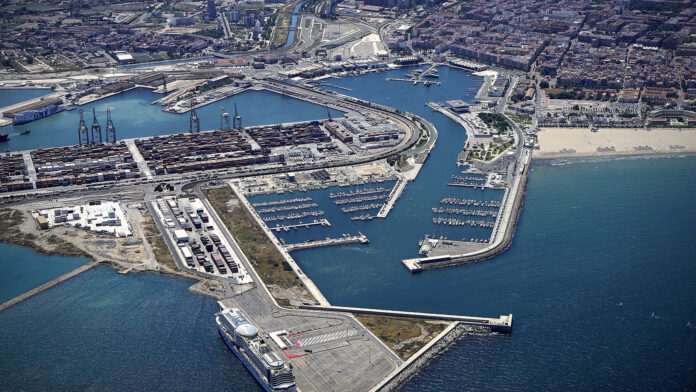The Port of Valencia (Valenciaport) in Spain is in the process of deploying a private 5G network to connect more than 25,000 handsets, tablets, vehicles, cameras, sensors, drones, and other devices, applications, and services. It has taken a 20 MHz chunk of the local n40 spectrum band at the site, which covers around six square miles, and handles around 77 million tonnes of cargo traffic and 4.8 million twenty-foot equivalent shopping units (TEUs) per year. It is the second busiest port in the Mediterranean after the port of Tanger (Tangiers) Med in Morocco.
The n40 band covers frequencies at 2300-2400 MHz (2.3-2.4 GHz), which the Spanish government has made available to enterprises in 20 MHz tranches. There is no word on supply partners, either for network equipment or integration services. But Nokia seems the likeliest candidate, if only because it is the single vendor brand that appears in easily-available public records of exploratory private 5G work from 2019, and also (maybe?) because of its track record at industrial plants with Spain-based Telefónica (search the archive) – which is the likeliest service provider, of whatever sort.
But this is only speculation; the story will be updated, as possible – and may, of course, be confirmed by multiple suppliers, separately, all feeding different port functions with private 5G technologies.
The Port Authority of València (PAV) has stuck out a press note that says the “project is [already] emerging as a key tool for… its digital transformation”, and that funding, worth nearly €6 million, has come in part (“co-funded”) from the the European Union’s Connecting Europe Facility (CEF) infrastructure investment fund for transport, energy, digital, and telecoms projects. The port said: “The deployment will be ad hoc to meet the needs of the port business and will operate independently of… a mobile operator.”
Indeed, PAV sought to distance itself, to an extent, from sharp-elbowed (as-a-service) suppliers, and implied its new 5G infrastructure will be managed in-house from the start. It said: “[This] completely private and dedicated solution involves the deployment of [the PAV’s] own network for exclusive use – which means total control of all decisions relating to this infrastructure in an independent and unilateral manner. The evolution and upgrades or growth of the infrastructure will also be in the hands of the PAV, acting independently and without the constraints of being dependent on a third party, with whom it may not be aligned in its interests.”
PVA provided further technical detail, as well: more than fifteen standalone 5G (5G SA) radio access (RAN) base stations will be deployed, it said, with “one, two and even three sectors” to provide “almost total coverage” of the port area; the 5G SA core network will also be hosted at the site, with full geo-redundancy (comprising a “cluster of two network controllers, which interconnect all basebands”) in case of mis-fires, outages, and other interruptions; the final infrastructure will support a max throughput of 10 Gbps; the network will be attended by a “high availability cyber security system”.
As well, the 20 MHz bandwidth allocation of n40 spectrum will be expandable to 40 MHz “soon”. As a side note, European countries have tended to make private 4G/5G spectrum available to enterprises in one of two bands: 20 MHz chunks of the the n40 band at 2.3-2.4 GHz, like Spain, and also Finland and France, or larger 100 MHz chunks of the n78 band at 3.3-3.8 GHz, variously like the UK, Germany, Poland, Switzerland, and Sweden. The EU is converging on the 3.8-4.2 GHz spectrum to standardise spectrum across the bloc for enterprise 4G/5G projects.
But despite the funding agreement and what-sounds-like some initial deployment work, as well as some big talk (the “project is [already] emerging…”) about the future, the rollout is in its early phases. “Improvement of the user experience will be a reality in 2027,” it said. The port is looking at future applications, including “5G coverage for passengers, digital twinning, intelligent surveillance, collision risk detection or stowage planning”, it said. But two major use cases – for “police surveillance” and remote maintenance – appear to have swung the initial project.
These have been flagged to test the network initially across the “entire territory”. It stated: “PAV is making improvements in the safety and security of the port, with measures such as the installation of cameras in police vehicles and equipment (such as in ‘waistcoats’ and [handheld devices]). The main objective… is to improve and strengthen the perimeter security and internal surveillance of the port. This network will enable enhanced mobile broadband connectivity to deploy a mobile surveillance solution that includes high-resn cameras for real-time recording and broadcasting of operations on the ground.
“Regarding the training of technicians [for remote maintenance], it is planned to implement immersive telepresence systems that, together with AI infrastructure… in the core network, will make it possible to replace the maintenance work that traditionally required the travel and presence of experts. This would allow local staff to carry out these tasks [remotely and] efficiently, provided they have real-time guidance through the advanced telepresence system.” In other words, the port is looking at sundry AR/VR systems and collaboration tools, as per fairly-standard industrial IoT rollout on new private 4G and 5G networks.

